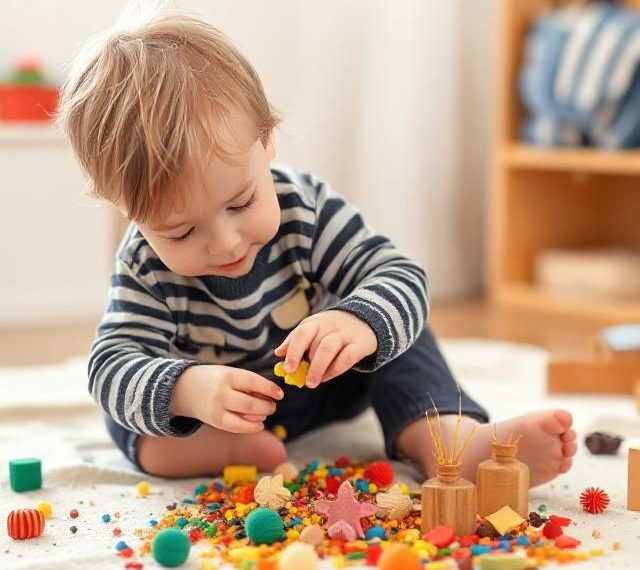Sensory play is a crucial aspect of a toddler’s development. It allows them to explore and understand the world around them through their senses. In this article, we will delve into the benefits of sensory play for toddlers and provide a comprehensive guide on how to incorporate sensory activities into your child’s daily routine.
What is Sensory Play?
Sensory play is any activity that engages a child’s senses, such as touch, sight, smell, taste, and hearing. These activities are often hands-on and open-ended, allowing children to explore and experiment in a safe and controlled environment. Sensory play can involve a wide range of materials, from water and sand to playdough and slime. The goal of sensory play is to stimulate a child’s senses and encourage them to use their imagination and creativity.
Why Sensory Play is Important for Toddlers
Sensory play is crucial for toddlers as it helps them make sense of the world around them. Toddlers are naturally curious and eager to explore their environment. By engaging in sensory play, they can use their senses to investigate different textures, smells, and tastes. This can help toddlers develop their cognitive abilities, enhance their problem-solving skills, and improve their language development.
Additionally, sensory play can also have a calming effect on toddlers. Many toddlers find comfort in engaging in sensory activities, as it provides them with a sense of security and familiarity. This can be especially helpful for toddlers who are experiencing anxiety or stress.
How to Incorporate Sensory Play into Your Toddler’s Routine
There are many ways to incorporate sensory play into your toddler’s daily routine. One simple way is to create a sensory bin filled with different materials such as rice, beans, or sand. Toddlers can use their hands to explore the materials, helping them develop their fine motor skills and tactile sensitivity.
You can also create sensory bottles filled with colorful liquids or items such as glitter or beads. Toddlers can shake the bottles and watch as the items move around, stimulating their visual and auditory senses.
Another fun sensory activity is to create a sensory bag filled with materials such as shaving cream or hair gel. Toddlers can squish and squeeze the bag, providing them with a tactile experience that can help them develop their hand-eye coordination.
Benefits of Sensory Play

There are numerous benefits of sensory play for toddlers. Some of the key benefits include:
1. Cognitive Development
Sensory play helps to stimulate a child’s brain and promote cognitive development. When children engage in sensory activities, they are using their senses to explore and make sense of the world around them. This helps to build connections in the brain and improve cognitive skills such as problem-solving, critical thinking, and creativity.
2. Fine Motor Skills
Sensory play often involves hands-on activities that require children to use their fine motor skills. Activities such as pouring, scooping, and squeezing help to strengthen the muscles in the hands and fingers, improving dexterity and coordination.
3. Language Development
Engaging in sensory play can also help to promote language development in toddlers. As children explore different textures, colors, and sounds, they are exposed to new vocabulary and concepts. This can help to expand their language skills and improve communication.
4. Social Skills
Sensory play can be a great way for toddlers to interact with others and develop social skills. Whether they are sharing materials, taking turns, or collaborating on a project, sensory play encourages cooperation and teamwork.
Types of Sensory Play
There are endless possibilities when it comes to sensory play for toddlers. Some popular types of sensory play include:
1. Water Play
Water play is a classic sensory activity that toddlers love. Whether it’s splashing in a pool, playing with water toys, or experimenting with water tables, water play can be a fun and refreshing way to engage the senses.
2. Sand Play
Sand play is another popular sensory activity that can provide hours of entertainment for toddlers. Playing with sand can help to improve fine motor skills, creativity, and sensory exploration.
3. Playdough Play
Playdough is a versatile material that can be used for a wide range of sensory activities. From shaping and molding to squishing and stretching, playdough play can help children develop their fine motor skills and creativity.
4. Sensory Bins
Sensory bins are containers filled with various materials that children can explore and manipulate. Common materials used in sensory bins include rice, beans, pasta, and pom poms. Sensory bins are a great way to encourage imaginative play and sensory exploration.
Tips for Engaging in Sensory Play with Toddlers

When engaging in sensory play with toddlers, it’s important to keep a few tips in mind to ensure a fun and safe experience:
1. Supervision
Always supervise children during sensory play activities to ensure their safety and well-being. Some materials used in sensory play, such as small objects or liquids, can pose a choking hazard.
2. Use Non-Toxic Materials
When selecting materials for sensory play, make sure to choose non-toxic and child-safe options. Avoid materials that may be harmful if ingested or cause skin irritation.
3. Encourage Exploration
Allow toddlers to explore and experiment with sensory materials at their own pace. Encourage them to use their senses to discover new textures, colors, and sounds.
4. Provide a Variety of Materials
Offer a variety of materials for sensory play to keep things interesting and engaging. Rotate different materials regularly to keep toddlers excited and curious.
Common Questions About Sensory Play
What age is appropriate for sensory play?
Sensory play is appropriate for children of all ages, including toddlers. Toddlers are naturally curious and eager to explore their environment, making them ideal candidates for sensory play activities. However, it is important to supervise toddlers during sensory play to ensure their safety and well-being.
What materials can I use for sensory play?
There are many materials that you can use for sensory play, including rice, beans, sand, water, shaving cream, and hair gel. You can also use items such as pom poms, beads, glitter, and feathers to add visual interest to sensory activities.
How can sensory play benefit my toddler’s development?
Sensory play can benefit your toddler’s development in many ways. It can help them develop their fine motor skills, cognitive abilities, language skills, and emotional well-being. Sensory play can also provide toddlers with a calming and relaxing experience, helping them unwind and reduce feelings of anxiety and stress.
Conclusion
Sensory play is a fun and valuable way for toddlers to engage with the world around them. By incorporating sensory activities into your child’s daily routine, you can help them develop essential skills and foster their creativity and imagination. Remember to provide a safe and stimulating environment for your child to explore and enjoy the benefits of sensory play.







































